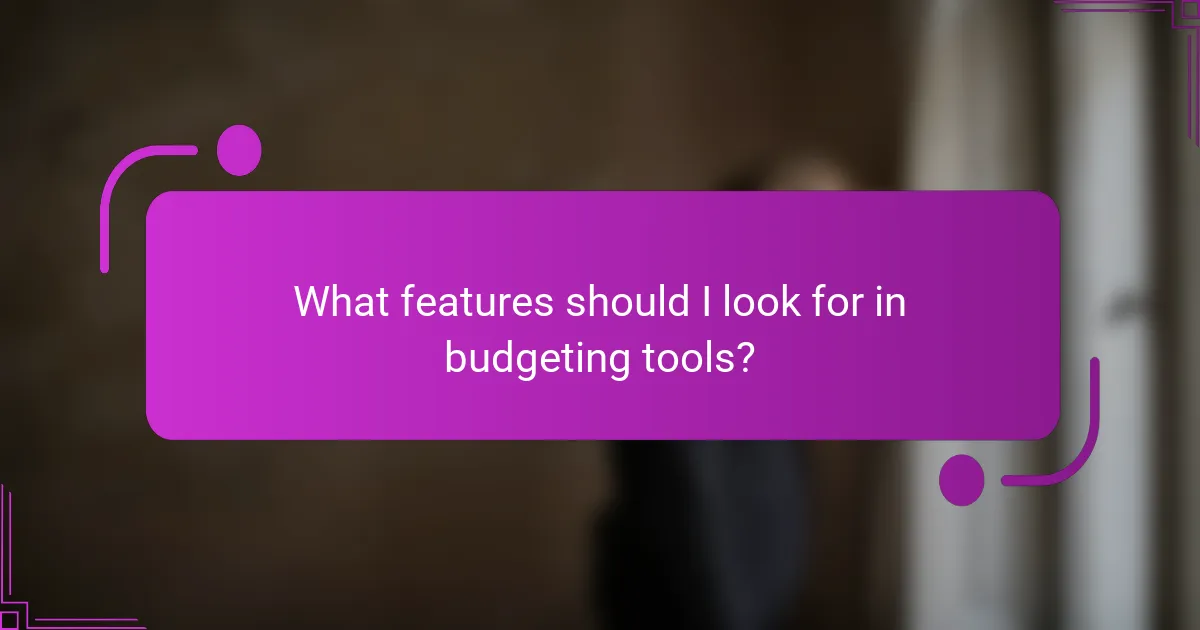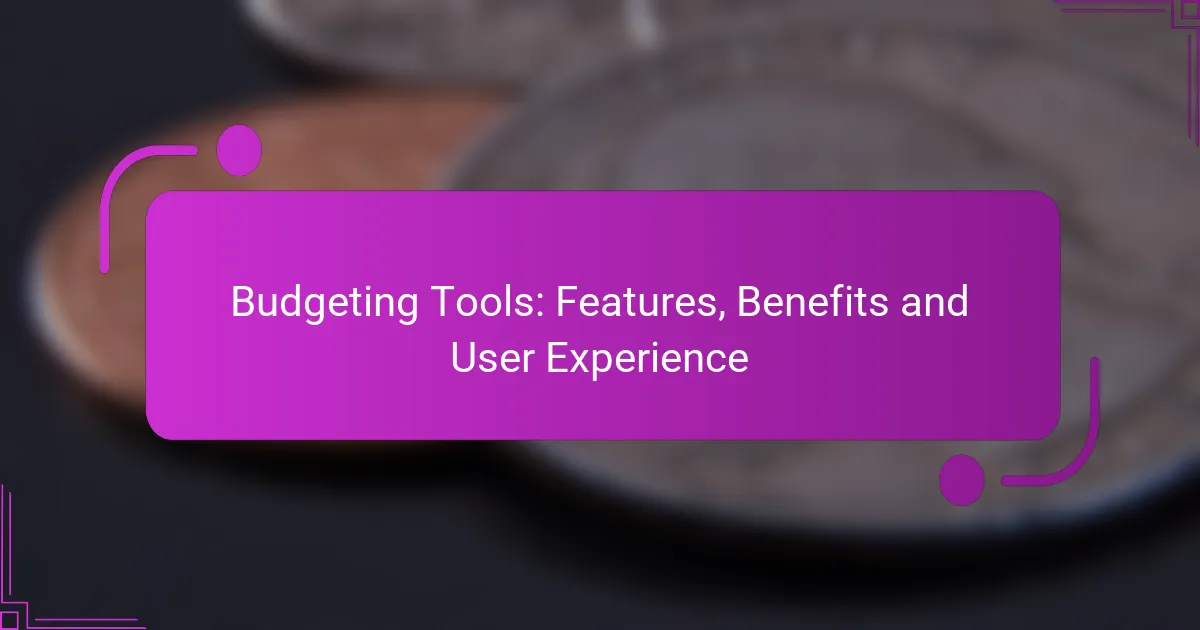Budgeting tools are essential for effective financial management, offering users structured methods to track income and expenses. With options like Mint, YNAB, and Personal Capital, each tool presents unique features designed to enhance usability and support diverse budgeting needs. By focusing on key functionalities such as expense tracking and goal setting, these tools empower users to make informed financial decisions and cultivate healthier spending habits.

What are the best budgeting tools available in the US?
The best budgeting tools in the US include Mint, YNAB, EveryDollar, Personal Capital, and GoodBudget. Each tool offers unique features and benefits tailored to different budgeting needs and user preferences.
Mint
Mint is a free budgeting tool that aggregates all your financial accounts in one place. It allows users to track spending, set budgets, and receive alerts for unusual transactions.
To get started, simply link your bank accounts and credit cards. Mint automatically categorizes transactions, making it easy to see where your money goes. However, some users may find the ads and promotional offers distracting.
YNAB (You Need A Budget)
YNAB is a paid budgeting tool designed to help users take control of their finances through proactive budgeting. It emphasizes the importance of assigning every dollar a job, which encourages mindful spending.
With YNAB, you can create customizable categories and track your spending in real time. The platform offers educational resources to help users improve their budgeting skills, but it may require a learning curve for beginners.
EveryDollar
EveryDollar is a straightforward budgeting tool that follows the zero-based budgeting method. Users can create a budget in minutes by dragging and dropping expenses into categories.
The free version allows for manual entry, while the paid version offers bank syncing for automatic updates. EveryDollar is user-friendly, but some features may be limited without the paid subscription.
Personal Capital
Personal Capital is a budgeting and investment tracking tool that provides a comprehensive view of your financial health. It combines budgeting features with investment analysis, making it ideal for users looking to manage both aspects.
Users can track expenses, set budgets, and analyze their investment portfolios. While the budgeting features are robust, the primary focus on investments may not suit those looking for a purely budgeting tool.
GoodBudget
GoodBudget is a digital envelope budgeting tool that allows users to allocate funds into different categories, similar to traditional envelope systems. It is particularly useful for those who prefer a cash-based budgeting approach.
The app is free to use with optional paid features for additional envelopes and accounts. GoodBudget is accessible on multiple devices, but users must manually enter transactions, which can be time-consuming for some.

What features should I look for in budgeting tools?
When selecting budgeting tools, focus on features that enhance usability, track expenses effectively, set financial goals, synchronize with bank accounts, and provide insightful reporting. These elements will help you manage your finances more efficiently and make informed decisions.
User-friendly interface
A user-friendly interface is crucial for effective budgeting tools. Look for software that offers intuitive navigation, clear layouts, and easy access to essential features. This will help you quickly understand your financial situation without feeling overwhelmed.
Consider tools that provide customizable dashboards, allowing you to prioritize the information most relevant to your budgeting needs. A clean design can significantly enhance your overall experience and encourage regular use.
Expense tracking
Expense tracking is a fundamental feature that allows you to monitor your spending habits. Choose budgeting tools that categorize expenses automatically, making it easier to see where your money goes. This can help identify areas where you can cut back.
Some tools offer manual entry options and receipt scanning, which can enhance accuracy. Look for features that allow you to set limits on specific categories to stay within budget.
Goal setting
Goal setting features enable you to define and track your financial objectives, such as saving for a vacation or paying off debt. Effective budgeting tools should allow you to create specific, measurable goals and monitor your progress over time.
Consider tools that provide reminders or alerts when you approach your goals or need to adjust your budget. This can help keep you motivated and accountable in your financial journey.
Bank synchronization
Bank synchronization allows budgeting tools to connect directly with your bank accounts, automatically importing transactions. This feature saves time and reduces the risk of manual entry errors, providing a more accurate financial picture.
Ensure the tool you choose supports secure connections with your bank and offers encryption to protect your sensitive information. Regular updates from your bank can help you stay on top of your finances without constant manual tracking.
Reporting and analytics
Reporting and analytics features provide insights into your financial habits and overall budget performance. Look for tools that generate visual reports, such as charts and graphs, to help you understand trends and make informed decisions.
Some budgeting tools offer customizable reports that can focus on specific time frames or categories, allowing for deeper analysis. This can help you identify spending patterns and adjust your budget accordingly for better financial health.

How do budgeting tools benefit users?
Budgeting tools provide users with structured methods to manage their finances, leading to better financial outcomes. By tracking income and expenses, these tools enhance awareness and promote healthier financial behaviors.
Improved financial awareness
Using budgeting tools increases users’ understanding of their financial situation. By visualizing income, expenses, and savings, individuals can identify spending patterns and areas for improvement. This heightened awareness often leads to more informed financial decisions.
For example, a user may discover they spend significantly on dining out, prompting them to adjust their habits to allocate more funds toward savings or debt repayment.
Better spending habits
Budgeting tools encourage users to develop better spending habits by setting limits and tracking expenditures. Users can categorize their spending, which helps them recognize unnecessary purchases and prioritize essential expenses. This practice fosters discipline and can lead to more mindful spending.
For instance, a monthly budget may allocate a specific amount for entertainment, helping users avoid overspending in that category.
Increased savings
By providing a clear overview of finances, budgeting tools can lead to increased savings. Users can set savings goals and monitor their progress, making it easier to allocate funds toward specific objectives, such as an emergency fund or a vacation.
Many budgeting tools allow users to automate transfers to savings accounts, ensuring that a portion of their income is consistently saved each month.
Debt reduction
Budgeting tools can significantly aid in debt reduction by helping users allocate funds specifically for debt repayment. By visualizing their debts and creating a repayment plan, users can prioritize high-interest debts and avoid accumulating additional charges.
For example, a user might focus on paying off credit card debt first, while making minimum payments on other loans, ultimately reducing their overall interest costs.
Goal achievement
Setting and achieving financial goals becomes more manageable with budgeting tools. Users can break down larger goals into smaller, actionable steps, making them less daunting. This structured approach helps maintain motivation and accountability.
For instance, if a user aims to save for a down payment on a home, they can set monthly savings targets and track their progress, making it easier to stay on track.

What is the user experience like with budgeting tools?
The user experience with budgeting tools typically focuses on ease of use, accessibility, and the ability to customize features to meet individual financial needs. Many users appreciate intuitive interfaces that simplify tracking expenses and managing budgets, while also valuing the support options available when issues arise.
Mobile app accessibility
Mobile app accessibility is crucial for users who want to manage their budgets on the go. Most budgeting tools offer mobile applications that allow users to track spending, set budgets, and receive alerts directly from their smartphones. This convenience enables users to input expenses in real-time, ensuring more accurate financial tracking.
When choosing a budgeting tool, consider the compatibility of the mobile app with your device’s operating system, whether it be iOS or Android. Many apps also offer offline functionality, which can be beneficial for users without consistent internet access.
Customer support options
Customer support options can significantly enhance the user experience with budgeting tools. Many providers offer multiple channels for assistance, including email, live chat, and phone support. Some tools also feature extensive FAQs and user forums where users can find answers to common questions.
When evaluating budgeting tools, check the availability of customer support during your preferred hours and the responsiveness of the service. Quick access to help can make a big difference, especially when users encounter issues while managing their finances.
Customization features
Customization features allow users to tailor budgeting tools to fit their specific financial situations. Many tools offer options to create personalized categories for expenses, set unique savings goals, and adjust the frequency of budget reviews. This flexibility can help users stay motivated and engaged with their budgeting process.
Look for budgeting tools that allow you to easily modify settings as your financial needs change. For example, being able to add or remove categories or adjust spending limits can provide a more accurate reflection of your financial landscape, making it easier to achieve your goals.


